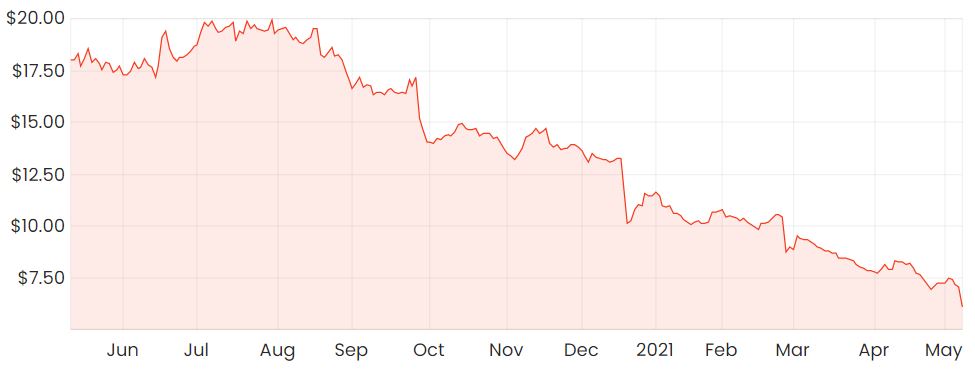Yesterday, The A2 Milk Company Ltd (ASX: A2M) delivered another disappointing trading update and downgraded FY21 earnings guidance for the fourth time in six months.
A2 milk shares opened 5% lower than yesterday, which now means A2 milk’s market valuation has tumbled to around 70% since reaching its highs in August last year.
To some value investors, an investment in A2 milk might be starting to look tempting at these levels.
However, as you can see from the downwards trend over the last nine months, catching a falling knife has proven to be a fairly risky contrarian play that has yet to yield a positive return.
A2M share price

Trading update recap
While it’s no surprise that the daigou/reseller market remains nearly at a standstill from where it once was, management have now revealed that it expects conditions to remain challenging for longer than what was originally thought.
Due to difficulties around visibility, a review of inventory revealed that the level of inventory on hand was much higher than expected.
While rebalancing and improving the dating of inventory will hopefully benefit consumers in the long run, this will come with the short-term cost of sacrificing revenue as the company reduces sell-in to the daigou channel, which may continue until Q1 FY22.
Management is now targeting FY21 revenue between $1.20 billion to $1.25 billion with earnings before interest, tax, depreciation and amortisation (EBITDA explained) margins at around 11% to 12%.
To put those figures into context, A2 milk reported revenue of $1.7 billion in FY20 with an EBITDA margin of 31%.
My take
I must admit that my view towards A2 milk has changed since writing about the company previously.
Initially, it seemed logical to think that the reopening of international borders would be the obvious catalyst that would see the company return to its former glory, but I’m not so sure anymore.
I think a recovery of some magnitude is likely, but in my view, it’s unlikely to see the same rapid growth in infant nutrition products in Asian markets even in a post-COVID economy, and I think the market will assign a much lower multiple to its shares. In other words, investors will be willing to pay less for the same amount of earnings (profit) it can generate.
Key growth drivers
It’s important to remember that majority of A2 milk’s fundamental growth over the past years has been the result of a surge in demand for infant nutrition (baby formula) products in Chinese markets.
Why did this happen?
Due to a tragic food scandal in China in 2008, which resulted in hundreds of babies being poisoned by the illicit use of melamine in baby formula produced by Chinese companies, the country’s authorities tried to curb consumption and domestic production of these sorts of products.
Australian companies like A2 went on to become the beneficiaries, with Chinese mothers willing to pay a premium price to have what was perceived as the best possible product on the market. The key risk here is that the success of the brand is therefore mainly determined by the sentiment surrounding the product. And what’s been happening recently is that Australian formula isn’t being perceived as premium as it once was.
Unhappy with foreign brands dominating the domestic milk market, Chinese authorities have recently been pushing for domestic producers to ramp up production again and have set a goal for producers to take a majority share of the country’s formula market.
One local Chinese brand, China Feihe appears to be a formidable competitor and plans to supply around one-third of the market for formula products by 2023. Feihe has been a strong performer recently as it’s been taking back market share, but even it has had to recently downgrade projections for demand due to declining birth rates in China.
As my colleague, Raymond Jang pointed out in his recent article, data released by the Chinese ministry of public security confirmed that the number of birth registrations had fallen from 11.8 million in 2019 to 10.03 million in 2020.
Summary
While investment in A2 milk might seem attractive from a contrarian standpoint, I think there are better opportunities elsewhere that aren’t operating in such challenging environments.
Management has been shuffled around recently, and significant insider selling occurred last year when the stock was trading at around $20 makes it difficult to have such a positive conviction moving forward in my eyes.
While this has described the potential bear case for A2’s shares, there are still some quality aspects of the company which I’d encourage you to read in my colleague, Lachlan Buur-Jensen’s article: The bull case for A2 Milk Company Ltd (ASX: A2M) shares.









